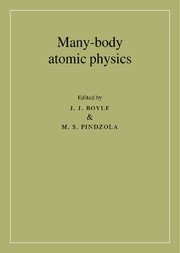Book contents
- Front Matter
- Contents
- Foreword
- Contributors
- Preface
- Acknowledgements
- Part 1 ATOMIC STRUCTURE
- Part 2 PHOTOIONIZATION OF ATOMS
- Part 3 ATOMIC SCATTERING: A. General Considerations
- Part 3 ATOMIC SCATTERING: B. Low-order applications
- 10 Perturbation series methods for calculating electron-atom differential cross sections
- 11 Target dependence of the triply differential cross section for low energy (e, 2e) processes
- 12 Overview of Thomas processes for fast mass transfer
- Part 3 ATOMIC SCATTERING: C. All-order applications
- Appendix: Units and notation
- References
- Index
10 - Perturbation series methods for calculating electron-atom differential cross sections
Published online by Cambridge University Press: 22 September 2009
- Front Matter
- Contents
- Foreword
- Contributors
- Preface
- Acknowledgements
- Part 1 ATOMIC STRUCTURE
- Part 2 PHOTOIONIZATION OF ATOMS
- Part 3 ATOMIC SCATTERING: A. General Considerations
- Part 3 ATOMIC SCATTERING: B. Low-order applications
- 10 Perturbation series methods for calculating electron-atom differential cross sections
- 11 Target dependence of the triply differential cross section for low energy (e, 2e) processes
- 12 Overview of Thomas processes for fast mass transfer
- Part 3 ATOMIC SCATTERING: C. All-order applications
- Appendix: Units and notation
- References
- Index
Summary
Introduction
The problem of electron–atom scattering is one of the oldest problems in atomic physics dating back to the early part of this century. This problem has often been studied and there were periods for which the problem was considered solved if one defined solved to mean that there was agreement between the existing experimental data and theoretical calculations. The early experimental measurements were typically total cross sections—that is cross sections summed over spins, summed over magnetic sub levels and integrated over scattering angles. For the case of atomic excitation, the measurements were normally performed for the allowed transitions. These cross sections were generally in reasonable agreement with the highly popular Born approximation which treats the projectile as a plane wave.
In the late 1960's and early 1970's, improved technology permitted the measurement of cross sections differential in the electron scattering angle following the collision. These more detailed cross sections revealed that the Born approximation was totally incorrect for large scattering angles. It was not possible to see this fact from the total cross sections which are dominated by the small angle differential cross sections (DCS). These DCS measurements revealed that an improved theoretical model was required. Most of the efforts in this direction since the early 1970's fall either into the category of a perturbation series approach or a non-perturbative close-coupling approach.
- Type
- Chapter
- Information
- Many-Body Atomic Physics , pp. 237 - 260Publisher: Cambridge University PressPrint publication year: 1998

